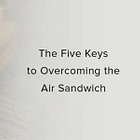The Air Sandwich: Why Your Big Picture and Day-to-Day Reality Don’t Link Up
The air is an illusion
[Note: This is a lightly modified excerpt from my book, Start Finishing.]
Imagine your life as if it were two slices of bread. Your vision, mission, purpose, and big goals compose the top slice of bread; your day-to-day reality is the bottom slice of bread. For many people, there’s a big gap between the two, leading to an air sandwich.1
At least that’s the way that it seems. In between the two slices of bread are actually five different challenges that combine to keep us from spending our days working on what matters most:
Competing priorities
Head trash
No realistic plan
Too few resources
Poor team alignment
Let’s take a look at each of these in turn.
Competing Priorities
Herding one goat is pretty straightforward; no matter how squirrelly it is, you can rein it in. Herding seven squirrelly goats is considerably harder because each goat goes its own way in search of whatever’s driving it at the moment.
Our lives are much closer to the seven-goat scenario in the sense that we’re often pulled in different directions to fulfill our desires. Our roles as parents require us to do things that may be at odds with our careers. Our desires to exercise seem to be at odds with our other hobbies. Our desires to travel can be at odds with our desires to save money. We have competing priorities.
Not every desire becomes a priority, but our deepest desires inform those priorities, especially if we believe Mahatma Gandhi’s “action expresses priority.” But even after we elevate some desires as priorities, they still compete. They’re just bigger, more insistent, and squirrelier goats at that point.
What’s even more challenging is that some of our operative priorities aren’t even ours or are nearly invisible to us. For instance, we prioritize keeping up with the Joneses unconsciously, and parents will sometimes discount how high a priority raising their children is when they examine why other things aren’t happening. So, on the one hand, we’re herding goats that don’t belong to us, and, on the other hand, we’re not counting some of the goats that we should be counting.
Head Trash
In Chapter 1 of Start Finishing, we quickly surveyed some of the stories we tell ourselves. Along with those general aspersions and self-limiting stories, we carry our own individual head trash that’s based on our own personal experiences, histories, and contexts.
While it’s true that much of this head trash is formed from our childhood experiences and families of origin, we also pick up new trash as adults. For instance, after a long string of not being able to create plans that work, we may tell ourselves that we’re either not good at planning or we’re “creative” — that is, not the type of person who can create and follow a plan. Thus when it comes time to do something big that requires planning, we can’t finish it, and we may end up creating another story about our not being able to do those best-work projects.
Some of us end up creating or holding on to stories that we’re somehow uniquely defective. Despite the ample evidence of people who are otherwise like us managing to be successful, overcoming difficulties, and mastering themselves, there’s something about us such that it won’t work for us. We end up fulfilling our own prophecy that we’re uniquely defective because other people just like us have figured it out and we haven’t.
Head trash always looks absurd when you state it directly because you see it for what it is. It’s the adult version of the monster under the bed; its power over us rests upon it remaining in the darkness.
No Realistic Plan
No realistic plan is a loaded challenge, with all three words being incredibly important. Some folks have a plan, but it’s not realistic. Others don’t have a plan because they don’t think it’s important or they’re not “the planning type.” Others confuse an aspiration or idea for a plan and aren’t getting anywhere.
To overcome the air sandwich, you’re going to need to connect your vision, purpose, and big goals with your day-to-day reality, and the type of projects that do that require creating realistic plans. Much of Start Finishing will show you how to do that, as well as how to create plans that adapt and shift with reality.
Too Few Resources
Many of us defer our best work because we think we have too few resources to achieve our goals. If we had more money, we’d start that nonprofit. If we had more time, we’d write the book. If we had the right contacts, we’d run for office.
In the meantime, we’re busy running down roads that may not necessarily get us any closer to the resources we need. And even when those roads serendipitously reveal the resources we need, we often don’t see them because we’re not open to seeing them in the same way that we don’t notice the coffee shop because we’re looking for a Starbucks.
President Theodore Roosevelt’s “do what you can, with what you’ve got, where you are2” also seems not to apply to us because our thing requires a lot more to start than what we have. We thus let what we don’t have keep us from creating what we can have.
Poor Team Alignment
We normally think about teams in the context of work or sports, but I’m applying teams to the broader cast of characters in your life. Similarly, I’m distinguishing your team from the mere people around you, because a lot of the people around you aren’t relevant to your doing your best work.
Think about those times in which you and your partner, friends, coworkers, or community were aligned and focused on shared goals. Now think about the times you weren’t. There’s likely a huge difference in effort, results, and joy between the two.
Many of us have poor team alignment not because the people on our team are in conflict but because we’re not communicating to our team what we want, need, and dream to be.
We may do this because we have the wrong people on our team and we’re thus afraid to be vulnerable enough to express our wants, needs, and dreams. In other cases, we do it because we don’t actually know what our true wants, needs, and dreams are and we’re waiting for inspiration to find us. In the meantime, people are following their own course and we often join their thing at the cost of our own.
The Five Challenges Work in Concert
We each struggle with one or two of the challenges above more than the others, but we also have multiple challenges working on us at once. That’s part of the reason we can remain stuck in the grind — we’re adept at solving simple, single-pronged challenges; complex, multipronged challenges, not so much.
For instance, because we’ve “learned” that we’re not the planning type (head trash), we have no realistic plan for how to do that big best-work project. Thus we don’t realize that there are small ways to get started (too few resources), and those around us who could help, don’t (poor team alignment). Or because we’re torn between wanting to travel or keeping our kids in a stable school environment (competing priorities), we don’t see that we can plan travel trips around school breaks (no realistic plan) and don’t save to do it (too few resources).
While “one thing at a time” is usually a prudent guideline, it doesn’t apply in addressing these five challenges. We can work on all of them at once in the sense that by intentionally working on one, we can address the others. To take the first example above, as soon as we embrace that there’s no such thing as a “planning type” (or that we can be one), we can start to create a realistic plan that uses the resources we have available and ask people to help us. Of course, asking people to help us may trigger more head trash about needing to ask for help, but we’re at least one step closer to making our days match the vision of our lives.
For more on the Air Sandwich and how to overcome it read part 2 and 3 of this series:
Though this quote is a ubiquitous Roosevelt-ism, he attributed it to Squire Bill Widener in his autobiography.







